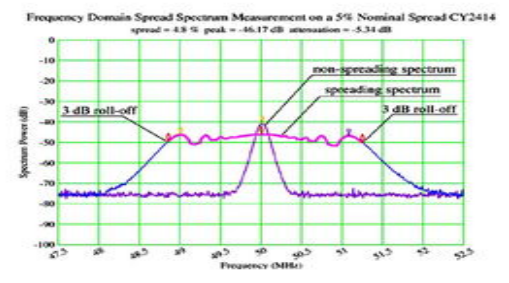Do you know what the spread spectrum clock generator is?
Spread Spectrum Clock Generator (SSCG) can be divided into programmable and non-programmable, or it can be classified according to whether it has Hershey Kiss frequency or triangular spread spectrum. The spread spectrum clocks of different consumer electronics products have different requirements for frequency, center or downward spread, spread amount, modulation frequency, Hershey Kiss or triangle spread spectrum.
Since the non-programmable spread spectrum clock chip is customized for specific applications, there are only a few fixed options for frequency range and expansion. It is very difficult to meet the optimal spread spectrum requirements while maximizing cost/performance.
Most fixed-function clock chips on the market have multiple fixed selectable input frequency ranges (eg 20-40MHz, 40-80MHz and 80-160MHz) and expansion rates (eg 0.5%, 1%, 2% and 3%). To achieve optimization, two sets of PLL parameters are required, one for EMI suppression and the other for PLL performance.
When the actual configuration deviates from these ideal settings, various side effects occur. For example, if the input frequency is not in the selected range, the VCO and modulation frequency will be adjusted linearly.

If the PLL bandwidth is too low, the frequency profile will be distorted, affecting EMI performance.
When the input frequency is lowest, the result is the worst: because the PDF and VCO frequencies are very low, the inter-cycle jitter is greatly increased, and the frequency profile may be distorted due to the low modulation frequency, and the EMI suppression performance is greatly reduced.
When the choice of the amount of expansion is limited, the developer must choose a larger amount of expansion beyond what is needed. This often increases inter-cycle jitter and reduces system timing budget.
If there isn't a scaling rate that meets the system requirements, developers must ask the clock vendor to make changes to the design and provide a new chip. In the process, even if it's just a matter of changing a metal layer, it takes at least a few weeks. Time, and the cost is generally very high.
In contrast, a programmable spread-spectrum clock generator provides a universal clock that supports field-programmability, combined with on-chip non-volatile memory for dynamic spread-spectrum parameter reset, eliminating the need for manufacturers to spend A lot of time and cost have changed the chip.
Programmability also allows the performance of the spread spectrum clock to be optimized for the required specifications. For example, developers can specify an exact rate of expansion of 2.1% (instead of 3% of a fixed selection) or optimize the modulation mode to achieve the desired frequency setting.
How to use a 4PLL type clock chip with 2 spread spectrum PLLs to easily reduce EMI by 3 to 4 dB by modulation frequency optimization. These extended PLLs are available in two independent expansion modes.
Most developers prefer to use the Hershey Kiss spread-spectrum clock for better EMI suppression, but many clock vendors only offer linear spread-spectrum clocks. Ideally, an SSCG must provide both Hershey Kiss and a linear spread spectrum clock. Demonstrating the Hershey Kiss spread spectrum clock, the one-time EMI reduced by 1.67dB under the 4PLL clock chip test conditions shown above.
In addition, important clock parameters, such as PLL charge pump current, VCO gain, and output drive strength, must be programmable. This flexibility can greatly improve system performance, reduce system development time, minimize changes and reduce risk.
If you want to know more, our website has product specifications for the clock generator, you can go to ALLICDATA ELECTRONICS LIMITED to get more information

